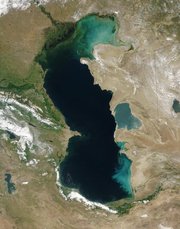Caspian Sea
|
|
The Caspian Sea or Mazandaran Sea is a landlocked sea between Asia and Europe (European Russia). It is the world's largest inland body of water, with a surface area of 371,000 km² (143,000 sq. mi.), and therefore has characteristics common to both seas and lakes. It is often listed as the world's largest lake, though it is not a freshwater one.
| Contents |
Geography
The Caspian Sea is bordered by Russia (Dagestan, Kalmykia, Astrakhan Oblast), Republic of Azerbaijan, Iran (Guilan, Mazandaran and Golestan provinces), Turkmenistan, and Kazakhstan, with the central Asian steppes to the north and east. On its eastern Turkmen shore is a large embayment, the Kara Bogaz Gol.
The sea is connected to the Sea of Azov by the Manych Canal.
Cities near the Caspian Sea
Major cities by the Caspian Sea:
- Astrakhan, Russia
- Baku, Republic of Azerbaijan
- Astara, Iran
- Derbent, Russia
- Anzali, Iran
- Turkmenbashi, Turkmenistan (formerly Krasnovodsk)
- Chalous, province of Mazandaran, Iran
- Atyrau, Kazakhstan (formerly Guriev)
- Aktau, Kazakhstan (formerly Shevchenko)
Baku_2.jpg
History
In Antiquity it was called the Hyrcanian Ocean. Other old names for the Caspian Sea include the Mazandaran Sea, Khazar Sea and the Khvalissian Sea.
Historical cities by the Sea include:
- Hyrcania, Iran
- Tamisheh, Iran
- Atil, Khazaria
- Khazaran
Fauna
The Caspian holds great numbers of sturgeon, which yield eggs that are processed into caviar. However, overfishing has threatened the sturgeon population to the point that environmentalists advocate banning sturgeon fishing completely until the population recovers.
Oil
The area is rich in energy wealth. As well as recently discovered oil fields, large natural gas supplies are also in evidence, though further exploration is needed to define their full potential. Geopolitical jockeying is taking place amongst Caspian-bordering countries, especially in the light of Middle East instability and the subsequent recasting of many Western countries' energy policies. Another factor influencing this is the new US military deployment to the Central Asian region.
A key problem is the status of the Caspian Sea and the establishment of the water boundaries between the five littoral countries. Russia, Azerbaijan and Kazahkstan signed an agreement in 2003 to divide the northern 64% of the sea between themselves, although the other two bordering countries, Iran and Turkmenistan, did not agree to this. This is likely to result in the three agreeing nations proceeding with oil development regardless; Iranian and Turkmen development is likely to stall.
At present, Azerbaijan and Kazahkstan have seen the biggest increase in oil production - an increase of 70% since 1992. Despite this, the region is still achieving less than potential output, with total regional production 1.6 million barrels (250,000 m³) per day - roughly equal to Brazil's production. This is expected to triple by 2010.
Characteristics and ecology
The Caspian has characteristics common to both seas and lakes. It is often listed as the world's largest lake, though it is not a freshwater lake.
The Volga River (about 80% of the inflow) and the Ural River discharge into the Caspian Sea, but it is endorheic, i.e. there is no natural outflow (other than by evaporation). Thus the Caspian ecosystem is a closed basin, with its own sea level history that is independent of the eustatic level of the world's oceans. The Caspian became landlocked about 5.5 million years ago. The level of the Caspian has fallen and risen, often rapidly, many times over the centuries. Some Russian historians claim that a medieval rising of the Caspian caused the coastal towns of Khazaria, such as Atil, to flood. In 2004, the water level is -28 metres, or 28 metres below sea level.
Over the centuries, Caspian Sea levels have changed in synchronicity with the estimated discharge of the Volga, which in turn depends on rainfall levels in its vast catchment basin. Precipitation is related to variations in the amount of North Atlantic depressions that reach the interior, and they in turn are affected by cycles of the North Atlantic Oscillation (see link). Thus levels in the Caspian sea relate to atmospheric conditions in the North Atlantic thousands of miles to the north and west. These factors make the Caspian Sea a valuable place to study the causes and effects of global climate change.
The last short-term sea-level cycle started with a sea-level fall of 3 m from 1929 to 1977, followed by a rise of 3 m from 1977 until 1995. Since then smaller oscillations have taken place[1] (http://www.caspage.citg.tudelft.nl/project.html). These changes have caused major environmental problems[2] (http://www.eia.doe.gov/emeu/cabs/caspenv.html).
Transportation
Several scheduled ferry services operate on the Caspian Sea, including:
- line between Turkmenbashi and Baku
See also
- Ekranoplan, the "Caspian Sea Monster"
- Tengiz Field
- Baku-Tbilisi-Ceyhan Pipeline
Other meanings
King Caspian X of Narnia is the fictional king of C. S. Lewis' Chronicles of Narnia.
External links
- Information on history and names of the Caspian Sea (http://www.netiran.com/?fn=artd(2277))
- Caspian Environment Programme (http://www.caspianenvironment.org/)
- Framework Convention for the Protection of the Marine Environment of the Caspian Sea (http://www.caspianenvironment.org/reports/Framework_Convention.zip) (2003)
- Target: Caspian Sea Oil (http://globalguerrillas.typepad.com/globalguerrillas/2004/07/long_term_gg_ta.html) John Robb, 2004
- Dating Caspian sea level changes (http://www.caspage.citg.tudelft.nl/project.html)bg:Каспийско море
da:Kaspiske Hav de:Kaspisches Meer et:Kaspia meri es:Mar Caspio eo:Kaspia Maro fa:دریای خزر fr:Mer Caspienne he:הים הכספי lt:Kaspijos jūra nl:Kaspische Zee id:Laut Kaspia ja:カスピ海 no:Kaspihavet pl:Morze Kaspijskie pt:Mar Cáspio ru:Каспийское море sk:Kaspické more fi:Kaspianmeri sv:Kaspiska havet zh:裏海

